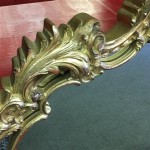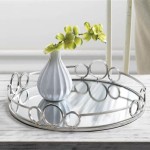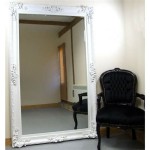Living Room Mirror Ideas
Mirrors offer a versatile design element, capable of transforming a living room's aesthetic and functionality. Strategically placed mirrors can amplify natural light, create an illusion of spaciousness, and serve as captivating focal points. This exploration delves into various mirror integration ideas for living rooms, considering diverse styles, sizes, and placement options.
Overmantle Mirrors: A Classic Choice
Positioning a mirror above the fireplace mantel remains a timeless design strategy. This placement draws the eye upward, emphasizing the fireplace as a central feature. A large, ornately framed mirror can add a touch of grandeur, while a simpler, frameless mirror offers a contemporary feel. The mirror's size should be proportional to the mantelpiece, ensuring visual balance and harmony.
Leaning Mirrors: A Casual Approach
For a more relaxed, informal aesthetic, consider leaning a large mirror against a wall. This approach offers flexibility in terms of placement and can easily be adjusted to suit changing needs. Leaning mirrors work particularly well in rooms with high ceilings, adding a sense of verticality and drama. The frame material can significantly impact the overall style – a rustic wooden frame lends a bohemian touch, while a sleek metal frame enhances a modern interior.
Gallery Walls with Mirrors: An Eclectic Mix
Integrating mirrors into a gallery wall introduces an element of surprise and reflectivity. Combining mirrors of varying shapes and sizes with framed artwork, photographs, and decorative objects creates a dynamic and personalized display. The strategic placement of mirrors within the gallery wall can enhance light distribution and add depth to the arrangement.
Mirrored Furniture: Subtle Elegance
Incorporating mirrored furniture pieces offers a subtle way to introduce reflective surfaces into the living room. A mirrored coffee table, side table, or console can add a touch of glamour and sophistication without overwhelming the space. These pieces reflect light and surrounding decor, creating a sense of depth and visual interest. However, it's important to exercise restraint with mirrored furniture to avoid an overly reflective environment.
Windowpane Mirrors: A Traditional Touch
Windowpane mirrors, characterized by their grid-like design, evoke a classic and timeless appeal. These mirrors can complement traditional or transitional living room styles, adding a touch of architectural detail. A large windowpane mirror hung above a sofa or console table can serve as a striking focal point, while smaller versions can be incorporated into gallery walls or placed on shelves.
Sunburst Mirrors: A Statement Piece
Sunburst mirrors, with their radiating frames, offer a dramatic and eye-catching design element. These mirrors can instantly elevate a living room, adding a touch of vintage glamour or bohemian flair depending on the frame material and finish. A sunburst mirror placed above a fireplace or on a prominent wall can serve as a captivating statement piece.
Round Mirrors: Softness and Harmony
Round mirrors introduce a sense of softness and harmony to a living room. Their curved shape contrasts with the often angular lines of furniture and architectural features, creating visual balance. A large round mirror placed above a console table or hung on a prominent wall can serve as a focal point, while smaller round mirrors can be grouped together for a decorative effect.
Placement Considerations for Maximizing Impact
The placement of mirrors within a living room significantly impacts their effectiveness. Consider positioning mirrors to reflect natural light sources, such as windows, to brighten the space. Avoid placing mirrors directly opposite windows, as this can create glare. Instead, position them on adjacent walls to capture and distribute light effectively.
Mirrors and Room Size: Creating Illusions of Space
In smaller living rooms, mirrors can be strategically used to create an illusion of spaciousness. Placing a large mirror on a wall opposite a window can visually double the size of the room. Using mirrors to reflect light can also make a small room feel brighter and more open.
Frame Styles and Materials: Complementing Existing Decor
The frame of a mirror plays a crucial role in its overall aesthetic. Choose a frame style and material that complements the existing décor. A simple, metallic frame suits modern and minimalist interiors, while an ornate, wooden frame complements traditional or vintage styles. Consider the color and finish of other furniture and decorative elements when selecting a mirror frame.
Maintenance and Care for Living Room Mirrors
Regular cleaning is essential to maintain the clarity and reflectivity of mirrors. Use a glass cleaner and a soft, lint-free cloth to wipe away dust and fingerprints. Avoid using abrasive cleaners or materials that can scratch the mirror surface. For mirrors in humid environments, ensure adequate ventilation to prevent moisture buildup.
By carefully considering these various mirror integration ideas, individuals can enhance their living room's aesthetic appeal and functionality, creating a space that is both visually captivating and welcoming.
Living Room Mirror Ideas 16 Stylish Tips That Dazzle

How To Decorate With Mirrors Decorating Ideas For

Living Room Mirror Ideas 13 Tips For Decor That Dazzles

10 Impressive Oversized Mirrors To Make Any Room Feel Bigger Large Mirror Living Wall

14 Mesmerizing Living Room Mirror Ideas The Best Mirrors

Top 10 Wall Mirror Designs For Your Living Room

Wall Mirror Design Ideas For Your Home Cafe

Decorative Wall Mirrors 40 Design Catalogue For Living Room Hallway Bathroom
:strip_icc()/DIY_Garrisons_4944-1-4urxjWEkqy3BSoJo_8m7Xo-7a915b090b424b5b9483a42bac98cd98.jpg?strip=all)
16 Ideas For Decorating With Mirrors

6 Ways Of Decorating Your Living Room With Mirrors Homelane Blog








